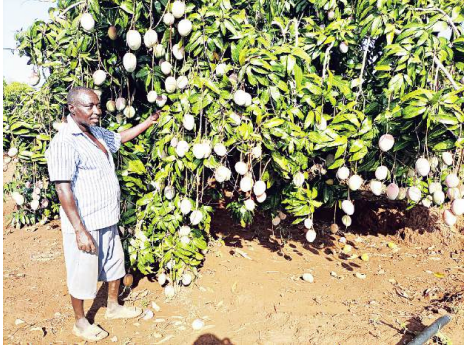

As a number of farmers in Kitui county stare at massive crop failure, those in Kitui Rural subcounty are expecting bumper harvests.
This follows an agricultural initiative, which has seen crops defy depressed October-December rainfall.
The initiative was implemented in Kanyangi and Kwa Vonza wards.
National Drought Management Authority coordinator Francis Koma and Kitui agriculture executive Stephen Kimwele earlier on warned of massive crop failure following the poor rainy season.
“It is true the October -December rains were inadequate and could not nurture most crops to maturity. Many farmers are facing crop failure,” Kimwele said.
He said the county government will put in place measures to cushion residents who will be affected.
Koma said his office is in the process of compiling data on food security across the county.
He said Kitui East, Mwingi Central and Mwingi North subcounties are the worst hit.
Adra Kenya, a Canadian-run NGO launched the The Nature Positive Food System for Climate Change Adaptation initiative, which saved Kitui Rural from imminent hunger.
The programme has seen farmers adopt conservation practices to preserve water and restore soil nutrients.
Conservative agriculture is pegged on three pillars which include minimum tillage by ripping, improved soil cover through mulching and crop rotation.
Some of the technologies farmers used include terracing and digging Zai pits.
The pits are dug between plant ing season and filled with organic fertilisers to attract worms, termites and other insects, creating material that can be used to fertilise crops.
Francis Muasya’s farm in Kanyangi ward boasts of lush green maize ready for harvesting, cowpeas and stalks of harvested mung beans.
He is one of the farmers undertaking conservation and regenerative agriculture technologies.
“As you can see, I am a happy man, I have food for my family despite the little rain in our area. This is all because I was trained and I put into practice Adra training,” the farmer said.
Muasya, said he employed the zai pit, terracing and mulching technologies to ensure the soil retained moisture longer. He spoke to the Star on Monday as he showed crops in different maturing stages.
“The trick was to ensure the moisture did not escape as soon as the rain stopped. It remained trapped in my farm to help my crops, including my water thirsty maize crop,” Muasya said.
He said conservation and regenerative agriculture could be the solution to vicious cycle of food insecurity.
Esther Jeremiah, a 54-year-old mother of four, is not having sleepless nights over lack of food.
Her farm in Itulani village of Kanyangi has good maize, cowpeas and green gram crops.
She said she will be harvesting her maize soon.
And just like the cowpeas and mung beans, the maize was planted in Zai pits.
“The best way to ensure we have food from our farms despite little rain, is by practicing conservation agriculture. It has worked miracles for me even with the minimal OND rain,” she said.
Conservation Agriculture champion, Sammy Mwonga, of Kalulini location said although the practice is labour intensive, it is the surest way of making families food secure.
He combined ripping, mulching and minimal soil disturbance for the good maize harvest.
Kitui Adra team leader David Kitheka said despite Kitui Rural receiving way below average rainfall, farmers practising conservation agriculture have had good harvests.
“The conservation agriculture approach is to ensure all the rain water is harvested and retained in the soil to help crops grow with limited rainfall,” he said.
Kitheka said the Canadian government is running the programme in areas with frequent below average rains and poor farming practices.
“Conservation agriculture is a sustainable soil and water conservation practice and techniques that give the small holder farmers an opportunity to maximise gains even with the below average rainfall,” he added.
He said the bottom line is to help
farmers make use of all the available
rain water and provide soil cover to
minimise loss of water through evaporation for sustained growth of their
crops.











